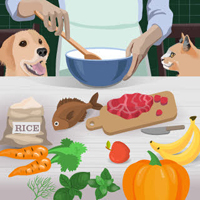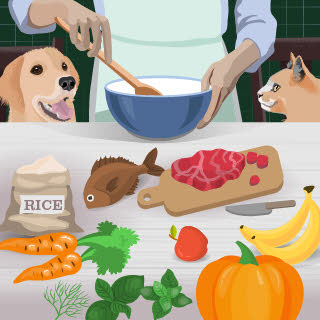
Homemade pet food

Digital art by Tamara Rees
Sources: Adobe Stock/artinspiring, zest_marina
Veterinary nutritionists evaluating 114 recipes for homemade cat foods obtained from veterinary textbooks, pet-care books and websites found problems with nutritional adequacy in every single one.
In a study published May 15 in the Journal of the American Veterinary Medical Association, researchers from the University of California, Davis, School of Veterinary Medicine, reported that even recipes written or supplied by veterinarians had shortcomings, although generally not as severe as those offered by non-veterinarians.
Problems ranged from vague instructions (for example, imprecise measurements such as "a whisker of catnip" or "some shrimp") to the inclusion of ingredients that potentially are toxic to cats (such as garlic, onions or leeks). Further, the majority of recipes were short on essential nutrients, either in type or concentration or both, when measured against National Research Council recommended allowances for adult cat maintenance diets.
The findings were consistent with earlier studies that examined the adequacy of recipes for homemade diets for dogs and cats with chronic kidney disease, published in JAVMA on March 1, 2012; and recipes for homemade maintenance diets for dogs, published in JAVMA on June 1, 2013.
As in the latest research, the earlier studies found recipes to be largely lacking in specificity and nutritional adequacy, and potentially harmful if fed long-term.
Dr. Jennifer Larsen, who led all three studies, said she and fellow nutritionists at the UC Davis Veterinary Teaching Hospital for years have found homemade diets fed to patients to be deficient.
"A lot of cats and dogs come to us already eating a home-cooked diet, following a recipe [that their owners] got online or from a book, or they got from a friend or a veterinarian," Larsen said in an interview.
In assessing patients' intake of calories and nutrients, Larsen said, "It's very uncommon for us to review a home-cooked diet and have it be balanced, regardless of where it came from. That's why we started assessing these more systematically."
In the most recent study, the researchers used a computer program to analyze the nutritional content of ingredients in the recipes. In the study published in 2013, the researchers used the computer program and also prepared foods from a subset of recipes, then had the foods analyzed in a laboratory. Comparing outcomes of the software analysis with that of the laboratory analysis showed that the formulation software on the whole produced reliable results, Larsen said.
Cooking up reliable recipes
Cooking for pets more complicated than many think
That general-practice veterinarians as well as laypeople put together fallible recipes might reflect overconfidence and/or an overall lack of understanding of the importance and complexity of nutrition, Larsen surmised.
"I think nutrition is really underappreciated in its role in health and disease," she said. Despite the fact that nutrition gets considerable "air time," she said, "at the level of the clinic, it's often not considered."
For board-certified veterinary nutritionists — of which the American College of Veterinary Nutrition directory shows 83 in the United States and Canada — however, formulating nutritionally balanced recipes for patients is a focal point.
The job of making pet food from scratch is not trivial. "Home-cooking is a lot of work, for sure," Larsen said, and that's apart from the nutritional content of the meals. For example, when personally cooking for a cat and a big dog, Larsen found the logistics challenging.
"It's helpful to have an extra freezer, for example, as well as multiple smaller containers for storing meals," she recounted, noting that cooking has to be done at least once a week and possibly more frequently, depending on storage space and batch sizes. "When cooking for my Newfoundland, I needed to purchase a bowl large enough to mix a full day's worth of food, but then it was too large to fit in my cabinets!"
Cooking for pets is in many ways harder than cooking for people. First of all, Larsen said, "People don't do a great job of feeding themselves. Our trace mineral status is actually pretty poor, and obesity is a common problem of malnutrition." Globally, poorly balanced diets result in conditions such as iron and iodine deficiencies, poor vitamin D status, and excessive sodium intake, she said, adding, "Even here in the U.S., this is why common human food staples are fortified," such as by enriching flour and pasta, adding iodine to salt and adding vitamins A and D to milk.
In dogs and cats, nutritional deficiencies can have greater consequences than in people because their life span is so much shorter. "It takes a human 15 to 20 years to become full grown, and that exceeds the life of a dog or cat," Larsen said. "They don't have that adaptability [to a poor diet] in that time span. We definitely see disease due to malnutrition in pets all the time, especially during the short and nutritionally demanding growth period." For example, she said she's had to euthanize animals afflicted by rickets, a bone deformity caused by insufficient vitamin D and calcium.
The process of devising sound recipes requires careful calculations of nutrients contained in each ingredient at the specified amounts of each ingredient, Larsen said. One difficulty with recipes found in books and online is that they commonly lack important details: "One of the things we found was no feeding instructions or calorie information," she said. "Even that simple thing can cause [health] issues — weight loss or weight gain. It also inappropriately puts the onus of feeding the right amount onto the pet owner."
Recipe formulators also need to be aware of the limitations of the nutritional database they're using. For example, the UC Davis researchers couldn't find nutritional information on bones, chicken backs and chicken necks — ingredients found in some recipes — because these are not foods typically eaten by people, Larsen said.
Some recipes call for the use of supplements. The study found fewer deficiencies in recipes using supplements, but even they still lacked sufficient amounts of one or more nutrients. And some lacked detail regarding the type and amount of supplement to add, Larsen said.
Twelve years later, melamine scare still drives search for alternative diets
How many pet owners mainly or exclusively make their animals' meals from scratch? A survey of pet feeding practices in the United States and Australia, published March 1, 2008 in JAVMA, found that fewer than 3% of respondents fed exclusively home-prepared diets, but about 7% of dogs received at least half their diet as home-prepared foods. Whether those proportions have increased during the past decade is unclear.
Anecdotally, homemade pet diets appear to have become more popular since the melamine scandal of 2007, when virtually every major brand of canned pet food was found to be contaminated by an industrial chemical. The problem was traced to unscrupulous suppliers in China, who sold mislabeled wheat gluten and rice protein concentrate. To raise the products' apparent protein content, the products had been spiked with melamine.
The scandal led to criminal convictions of the owners of a U.S.-based import company and a $12.4 million class action settlement in a civil case that pitted thousands of pet-owner plaintiffs against major marketers and vendors of some 180 brands of commercial pet food.
"We had a huge increase in interest in home-cooking at the time," Larsen said. Interest has remained high, reflecting "a long-term, persistent distrust in some — but not all — commercial pet food manufacturing," she said.
Besides interest in home-cooked pet foods, the post-melamine world saw a profusion of new offerings on pet-food shelves from marketers touting "human-grade" ingredients and "grain free" formulations — the latter of which recently have generated health concerns, as well.
Larsen said making pet meals from scratch reflects many owners' love for their pets. "Typical of what we hear is that sometimes the owner wants to cook for the pet as part of tending to the pet, especially when they get the news of a terminal or otherwise devastating diagnosis," she said.
Other times, people take to the kitchen because their animal has a disease that requires specific nutritional modifications but the animal won't eat the commercial diet available for the condition.
Even when home-prepared meals are fed in combination with commercial diets, it's important they provide balanced nutrition, Larsen said. "For unbalanced foods, we advise that these comprise no more than 10% of the daily calories," she said. "... If you provide excessive amounts of foods that only provide calories but not the full complement of essential nutrients, you risk unbalancing the overall diet."
This story has been changed to remove a reference to an online resource that is no longer available.